Zhangjie Fu
Is Artificial Intelligence Generated Image Detection a Solved Problem?
May 18, 2025Abstract:The rapid advancement of generative models, such as GANs and Diffusion models, has enabled the creation of highly realistic synthetic images, raising serious concerns about misinformation, deepfakes, and copyright infringement. Although numerous Artificial Intelligence Generated Image (AIGI) detectors have been proposed, often reporting high accuracy, their effectiveness in real-world scenarios remains questionable. To bridge this gap, we introduce AIGIBench, a comprehensive benchmark designed to rigorously evaluate the robustness and generalization capabilities of state-of-the-art AIGI detectors. AIGIBench simulates real-world challenges through four core tasks: multi-source generalization, robustness to image degradation, sensitivity to data augmentation, and impact of test-time pre-processing. It includes 23 diverse fake image subsets that span both advanced and widely adopted image generation techniques, along with real-world samples collected from social media and AI art platforms. Extensive experiments on 11 advanced detectors demonstrate that, despite their high reported accuracy in controlled settings, these detectors suffer significant performance drops on real-world data, limited benefits from common augmentations, and nuanced effects of pre-processing, highlighting the need for more robust detection strategies. By providing a unified and realistic evaluation framework, AIGIBench offers valuable insights to guide future research toward dependable and generalizable AIGI detection.
A Comprehensive Survey on Visual Concept Mining in Text-to-image Diffusion Models
Mar 17, 2025Abstract:Text-to-image diffusion models have made significant advancements in generating high-quality, diverse images from text prompts. However, the inherent limitations of textual signals often prevent these models from fully capturing specific concepts, thereby reducing their controllability. To address this issue, several approaches have incorporated personalization techniques, utilizing reference images to mine visual concept representations that complement textual inputs and enhance the controllability of text-to-image diffusion models. Despite these advances, a comprehensive, systematic exploration of visual concept mining remains limited. In this paper, we categorize existing research into four key areas: Concept Learning, Concept Erasing, Concept Decomposition, and Concept Combination. This classification provides valuable insights into the foundational principles of Visual Concept Mining (VCM) techniques. Additionally, we identify key challenges and propose future research directions to propel this important and interesting field forward.
Generalizable Deepfake Detection via Effective Local-Global Feature Extraction
Jan 25, 2025



Abstract:The rapid advancement of GANs and diffusion models has led to the generation of increasingly realistic fake images, posing significant hidden dangers and threats to society. Consequently, deepfake detection has become a pressing issue in today's world. While some existing methods focus on forgery features from either a local or global perspective, they often overlook the complementary nature of these features. Other approaches attempt to incorporate both local and global features but rely on simplistic strategies, such as cropping, which fail to capture the intricate relationships between local features. To address these limitations, we propose a novel method that effectively combines local spatial-frequency domain features with global frequency domain information, capturing detailed and holistic forgery traces. Specifically, our method uses Discrete Wavelet Transform (DWT) and sliding windows to tile forged features and leverages attention mechanisms to extract local spatial-frequency domain information. Simultaneously, the phase component of the Fast Fourier Transform (FFT) is integrated with attention mechanisms to extract global frequency domain information, complementing the local features and ensuring the integrity of forgery detection. Comprehensive evaluations on open-world datasets generated by 34 distinct generative models demonstrate a significant improvement of 2.9% over existing state-of-the-art methods.
Large Language Models are Good Attackers: Efficient and Stealthy Textual Backdoor Attacks
Aug 21, 2024



Abstract:With the burgeoning advancements in the field of natural language processing (NLP), the demand for training data has increased significantly. To save costs, it has become common for users and businesses to outsource the labor-intensive task of data collection to third-party entities. Unfortunately, recent research has unveiled the inherent risk associated with this practice, particularly in exposing NLP systems to potential backdoor attacks. Specifically, these attacks enable malicious control over the behavior of a trained model by poisoning a small portion of the training data. Unlike backdoor attacks in computer vision, textual backdoor attacks impose stringent requirements for attack stealthiness. However, existing attack methods meet significant trade-off between effectiveness and stealthiness, largely due to the high information entropy inherent in textual data. In this paper, we introduce the Efficient and Stealthy Textual backdoor attack method, EST-Bad, leveraging Large Language Models (LLMs). Our EST-Bad encompasses three core strategies: optimizing the inherent flaw of models as the trigger, stealthily injecting triggers with LLMs, and meticulously selecting the most impactful samples for backdoor injection. Through the integration of these techniques, EST-Bad demonstrates an efficient achievement of competitive attack performance while maintaining superior stealthiness compared to prior methods across various text classifier datasets.
CurveFormer: 3D Lane Detection by Curve Propagation with Curve Queries and Attention
Sep 16, 2022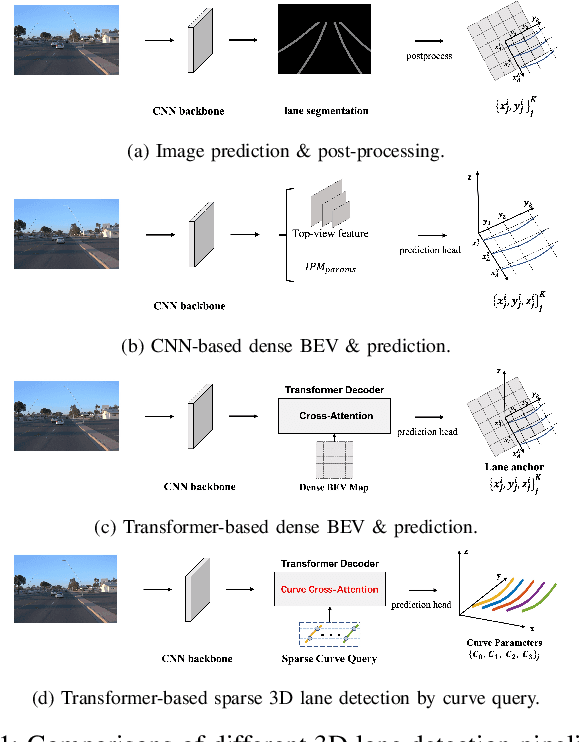
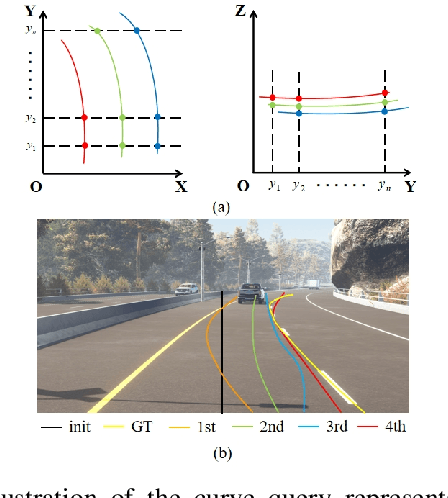
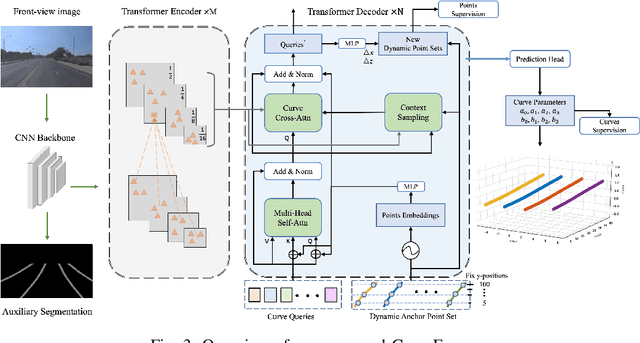
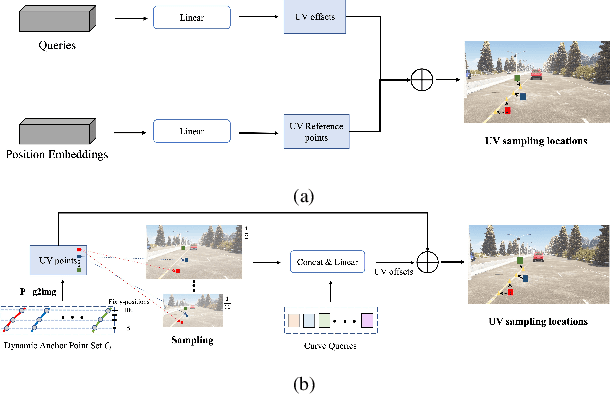
Abstract:3D lane detection is an integral part of autonomous driving systems. Previous CNN and Transformer-based methods usually first generate a bird's-eye-view (BEV) feature map from the front view image, and then use a sub-network with BEV feature map as input to predict 3D lanes. Such approaches require an explicit view transformation between BEV and front view, which itself is still a challenging problem. In this paper, we propose CurveFormer, a single-stage Transformer-based method that directly calculates 3D lane parameters and can circumvent the difficult view transformation step. Specifically, we formulate 3D lane detection as a curve propagation problem by using curve queries. A 3D lane query is represented by a dynamic and ordered anchor point set. In this way, queries with curve representation in Transformer decoder iteratively refine the 3D lane detection results. Moreover, a curve cross-attention module is introduced to compute the similarities between curve queries and image features. Additionally, a context sampling module that can capture more relative image features of a curve query is provided to further boost the 3D lane detection performance. We evaluate our method for 3D lane detection on both synthetic and real-world datasets, and the experimental results show that our method achieves promising performance compared with the state-of-the-art approaches. The effectiveness of each component is validated via ablation studies as well.
BEVSegFormer: Bird's Eye View Semantic Segmentation From Arbitrary Camera Rigs
Mar 13, 2022


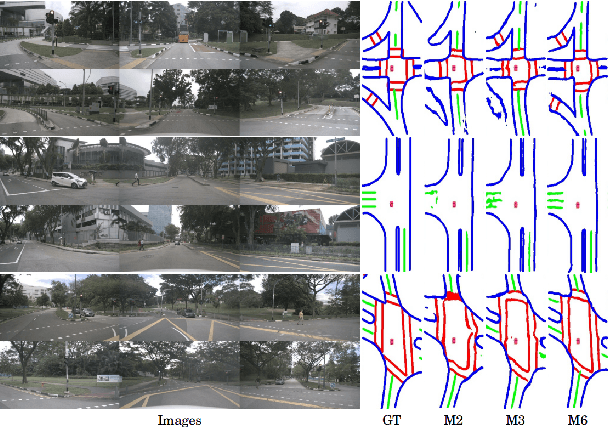
Abstract:Semantic segmentation in bird's eye view (BEV) is an important task for autonomous driving. Though this task has attracted a large amount of research efforts, it is still challenging to flexibly cope with arbitrary (single or multiple) camera sensors equipped on the autonomous vehicle. In this paper, we present BEVSegFormer, an effective transformer-based method for BEV semantic segmentation from arbitrary camera rigs. Specifically, our method first encodes image features from arbitrary cameras with a shared backbone. These image features are then enhanced by a deformable transformer-based encoder. Moreover, we introduce a BEV transformer decoder module to parse BEV semantic segmentation results. An efficient multi-camera deformable attention unit is designed to carry out the BEV-to-image view transformation. Finally, the queries are reshaped according the layout of grids in the BEV, and upsampled to produce the semantic segmentation result in a supervised manner. We evaluate the proposed algorithm on the public nuScenes dataset and a self-collected dataset. Experimental results show that our method achieves promising performance on BEV semantic segmentation from arbitrary camera rigs. We also demonstrate the effectiveness of each component via ablation study.
 Add to Chrome
Add to Chrome Add to Firefox
Add to Firefox Add to Edge
Add to Edge